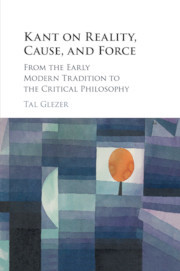Description
Kant on Reality, Cause, and Force
From the Early Modern Tradition to the Critical Philosophy
Author: Glezer Tal
Original analysis of Kant's category of reality, with wide-ranging implications for understanding his critical philosophy and its development.
Language: English
Subject for Kant on Reality, Cause, and Force:
Approximative price 32.87 €
In Print (Delivery period: 14 days).
Add to cart
Kant on Reality, Cause, and Force
Publication date: 01-2020
Support: Print on demand
Publication date: 01-2020
Support: Print on demand
Kant on Reality, Cause, and Force
Publication date: 01-2018
236 p. · 15.6x23.5 cm · Hardback
Publication date: 01-2018
236 p. · 15.6x23.5 cm · Hardback
Description
/li>Contents
/li>Biography
/li>
Kant's category of reality is an often overlooked element of his Critique of Pure Reason. Tal Glezer shows that it nevertheless belongs at the core of Kant's mature critical philosophy: it captures an issue that motivated his critical turn, shaped his theory of causation, and established the role of his philosophy of science. Glezer's study traces the roots of Kant's category of reality to early modern debates over the intelligibility of substantial forms, fueled by the tension between the idea of non-extended substances and that of extended objects. This tension influenced Kant's pre-critical work, and eventually inspired his radical break towards transcendental idealism. Glezer explores the importance of reality for Kant's conceptions of cause and force, and sheds new light on his philosophy of physical science, including gravity. His book will interest scholars of Kant and of early modern philosophy, as well as historians of scientific ideas.
Acknowledgements; List of abbreviations; Introduction: 'what corresponds to sensation'; Part I. Substantial Forms and Reality: 1. Reality and substantial forms in Descartes and Suárez; 1.1. Reality-containment and substantial forms in Descartes and Suárez; 1.2. Causation and substantial forms in Descartes and Suárez; 1.3. Descartes on the intelligibility of substantial forms; 2. Vis Viva and the essence of matter; 2.1. Vis Viva and quantity of motion; 2.2. Vis Viva and 'quantity of progress'; 2.3. Vis Viva and potential energy; 2.4. Potential energy and substantial forms; 2.5. Living and dead forces, primitive and derivative forces in Leibniz's Specimen Dynamicum; 2.6. The principle of sufficient reason and the intelligibility of substantial forms; 3. Leibniz on the law of continuity; 3.1. Leibniz on the law of continuity in mathematics; 3.2. Leibniz on the law of continuity in physics; 3.3. Leibniz's law of continuity and genus-species subordination; Part II. The Magnitude of Reality: 4. Reality and magnitude in Kant's Negative Magnitudes; 4.1. The validity of mathematical concepts in philosophy; 4.2. Negative magnitudes and real opposition; 4.3. Kant's main argument in Negative Magnitudes Section III; 4.4. Ground and consequence, and the law of continuity in Negative Magnitudes; 5. The category of reality and the law of continuity; 5.1. Kant's classification of laws of continuity; 5.2. Laws of continuity in Kant's Inaugural Dissertation; 5.3. The law of continuity's place in the table of categories; 5.4. The ground of sensation in the Inaugural Dissertation and in the CPR; 6. Objectivity and the quantification of reality; 6.1. Objectivity and the concepts of quality; 6.2. Why qualities should have quantities; 6.3. Intensive magnitudes and the anticipations of perception; 7. Reality, causation, and motion; 7.1. Reality and causation; 7.2. Simultaneous and instantaneous causation; 7.3. Reality and motion; 7.4. Reality, motion, and the moment of change; Part III. The All of Reality: 8. Metaphysical and mechanical laws of the continuity of alteration; 8.1. The continuity of alteration in the CPR; 8.2. The continuity of alteration in the MFNS; 9. The second analogy and the uniformity of nature; 9.1. The second analogy and the existence of empirical laws; 9.2. 'An unbounded diversity of empirical laws'; 9.3. The applicability of transcendental principles in experience; 10. Reality and the system of all possible empirical concepts; 10.1. Kant and Leibniz on the idea of a system of all possible empirical concepts; 10.2. Transcendental ideas and the concept of realitas noumenon; 10.3. Transcendental ideas and the pure use of reason; 10.4. Transcendental ideas and the property of continuity; 10.5. The transcendental ideas and the regulative principles of science; 11. Reality and the derivation of rgavitation; 11.1. Kant's example of genus-species subordination in the appendix to the dialectic; 11.2. Kant's example and the continuity of conic sections; 11.3. Kant's example and Newton's derivation of gravitation; 11.4. Kant on Newton and the objective validity of motion; 11.5. Kant on genus-species subordination and Newton's derivation of gravitation; Conclusion; Bibliography.
Tal Glezer is a researcher at the Max Planck Institute for the History of Science in Berlin.
© 2024 LAVOISIER S.A.S.




